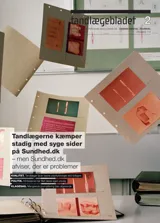Å utføre en fylling. Aspekter ved praktiske restaureringsprosedyrer
Restaurering av middels til store defekter i posteriore tenner kan være utfordrende og tidkrevende, spesielt ved store og subgingivale approksimale defekter. For å oppnå en god adaptasjon mellom fyllingsmateriale og tannsubstans er riktig behandling av bondingmaterialer og kompositter avgjørende. Det anbefales alltid å følge produsentens instruksjoner og anbefalinger, men herdetiden må økes der det er stor avstand til herdelampen. Som alternativ til bomullsruller og andre absorberende materialer i kombinasjon med vakuumsug er kofferdam et godt egnet hjelpemiddel til en effektiv tørrlegging av arbeidsfeltet. Anatomisk form med tette og riktig plasserte kontaktpunkt til nabotenner reduserer faren for randkristafraktur og »food-impaction «. Ved korrekt bruk av interdentale kiler og separasjonsringer kan ulike matrisesystem fungere godt. Et passivt system som ikke er avhengig av press og manipulering under herdeprosessen, gir best resultat. Ved oppbygging av restaureringen er skrålagsteknikk anbefalt for å oppnå tilstrekkelig herding, minimale kontraksjonsspenninger og derved mindre fare for spalter og mikrolekkasje.
Placement of a filling. Aspects of operative restoration procedures Restoration of medium to large defects in posterior teeth can be challenging and time-consuming, especially when working with extensive and subgingival preparations. As an alternative to cotton rolls and other absorbing materials in combination with a saliva ejector, rubber dam is a suitable supplement for moisture control. An appropriate anatomical shape of the restoration, with tight and correctly placed contacts to the neighbouring teeth reduces the risk of fracture of the marginal ridge and food impaction. Different matrix systems can perform well in combination with interdental wedges and separation rings. A passive system that is not dependent on manual pressure or manipulation during the curing provides the best results. Proper handling of the adhesive and the composite is crucial. The manufacturers’ instructions and recommendations should be adhered to, and the curing time has to be increased when there is a longer than normal distance from the curing device to the material. An oblique incremental technique is recommended to achieve adequate curing and minimal contraction stress, which would reduce the risk of voids and leakage.


